2.4 Genetics, Evolutionary Psychology, and Behavior
Behavior Genetics: Predicting Individual Differences
2-
Our shared brain architecture predisposes some common behavioral tendencies. Whether we live in the Arctic or the tropics, we sense the world, develop language, and feel hunger through identical mechanisms. We prefer sweet tastes to sour. We divide the color spectrum into similar colors. And we feel drawn to behaviors that produce and protect offspring.

Our human family shares not only a common biological heritage—
environment every nongenetic influence, from prenatal nutrition to the people and things around us.
heredity the genetic transfer of characteristics from parents to offspring.
behavior genetics the study of the relative power and limits of genetic and environmental influences on behavior.
But in important ways, we also are each unique. We look different. We sound different. We have varying personalities, interests, and cultural and family backgrounds. What causes our striking diversity? How much of it is shaped by our differing genes, and how much by our environment—by every external influence, from maternal nutrition while in the womb to social support while nearing the tomb? How does our heredity interact with our experiences to create both our universal human nature and our individual and social diversity? Such questions intrigue behavior geneticists.
Genes: Our Codes for Life
chromosomes threadlike structures made of DNA molecules that contain the genes.
DNA (deoxyribonucleic acid) a complex molecule containing the genetic information that makes up the chromosomes.
genes the biochemical units of heredity that make up the chromosomes; segments of DNA capable of synthesizing proteins.
genome the complete instructions for making an organism, consisting of all the genetic material in that organism’s chromosomes.
Barely more than a century ago, few would have guessed that every cell nucleus in your body contains the genetic master code for your entire body. It’s as if every room in Dubai’s Burj Khalifa (the world’s tallest building) contained a book detailing the architect’s plans for the entire structure. The plans for your own book of life run to 46 chapters—
Genetically speaking, every other human is nearly your identical twin. Human genome researchers have discovered the common sequence within human DNA. This shared genetic profile makes us humans, rather than tulips, bananas, or chimpanzees.
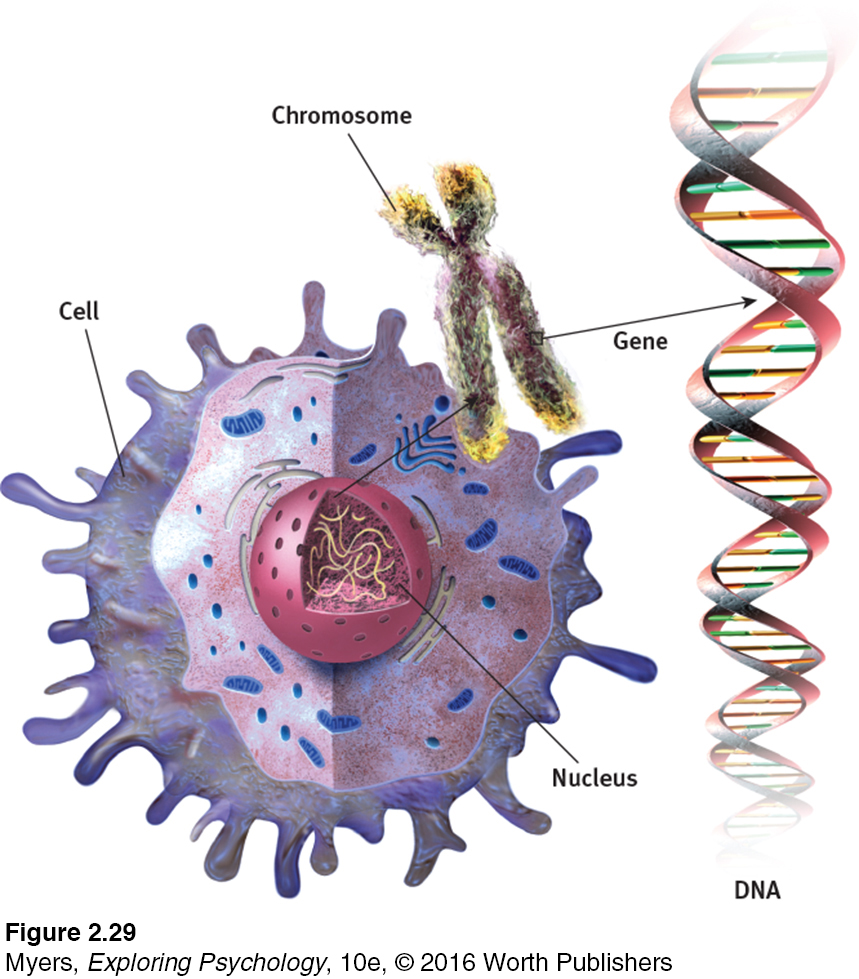
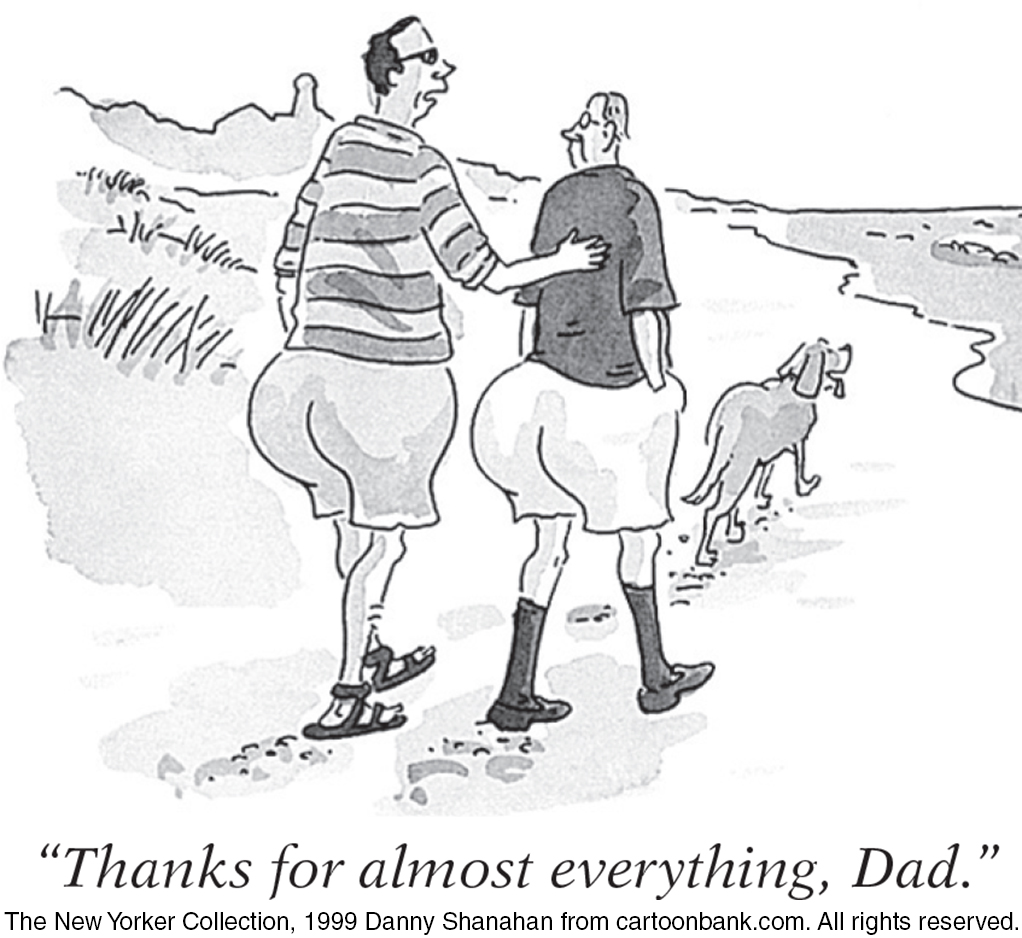
“We share half our genes with the banana.”
Evolutionary biologist Robert May, president of Britain’s Royal Society, 2001
The occasional variations found at particular gene sites in human DNA fascinate geneticists and psychologists. Slight person-
Most of our traits have complex genetic roots. How tall you are, for example, reflects the size of your face, vertebrae, leg bones, and so forth—
“Your DNA and mine are 99.9 percent the same. . . . At the DNA level, we are clearly all part of one big worldwide family.”
Francis Collins, Human Genome Project director, 2007
RETRIEVE IT
Question
Put the following cell structures in order from smallest to largest: nucleus, gene, chromosome
Question
When the mother's egg and the father's sperm unite, each contributes 23 .
Twin and Adoption Studies
2-14 How do twin and adoption studies help us understand the effects and interactions of nature and nurture?
 See LaunchPad’s Video: Twin Studies, below for a helpful tutorial animation.
See LaunchPad’s Video: Twin Studies, below for a helpful tutorial animation.
To scientifically tease apart the influences of environment and heredity, behavior geneticists could wish for two types of experiments. The first would control heredity while varying the home environment. The second would control the home environment while varying heredity. Although such experiments with human infants would be unethical, nature has done this work for us.
identical (monozygotic) twins develop from a single fertilized egg that splits in two, creating two genetically identical organisms.
IDENTICAL VERSUS FRATERNAL TWINS Identical (monozygotic) twins develop from a single fertilized egg that splits in two. Thus they are genetically identical—
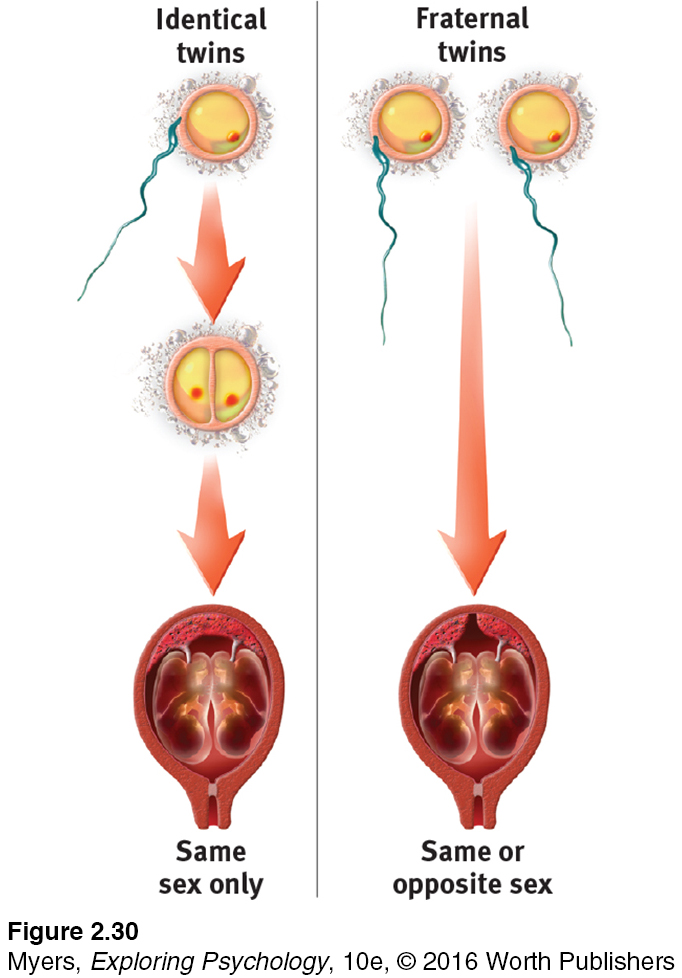
fraternal (dizygotic) twins develop from separate fertilized eggs. They are genetically no closer than ordinary brothers and sisters, but they share a prenatal environment.
Fraternal (dizygotic) twins develop from two separate fertilized eggs. As womb-mates, they share a prenatal environment, but they are genetically no more similar than ordinary brothers and sisters.
Shared genes can translate into shared experiences. A person whose identical twin has autism spectrum disorder, for example, has about a 3 in 4 risk of being similarly diagnosed. If the affected twin is fraternal, the co-twin has about a 1 in 3 risk (Ronald & Hoekstra, 2011). To study the effects of genes and environments, hundreds of researchers have studied some 800,000 identical and fraternal twin pairs (Johnson et al., 2009).
Are genetically identical twins also behaviorally more similar than fraternal twins? Studies of thousands of twin pairs have found that identical twins are much more alike in extraversion (outgoingness) and neuroticism (emotional instability) than are fraternal twins (Kandler et al., 2011; Laceulle et al., 2011; Loehlin, 2012).
Identical twins, more than fraternal twins, look alike. So, do people’s responses to their looks account for their similarities? No. In one clever study, a researcher compared personality similarity between identical twins and unrelated look-

SEPARATED TWINS Imagine the following science fiction experiment: A mad scientist decides to separate identical twins at birth, then raise them in differing environments. Better yet, consider a true story:
On a chilly February morning in 1979, some time after divorcing his first wife, Linda, Jim Lewis awoke in his modest home next to his second wife, Betty. Determined to make this marriage work, Jim made a habit of leaving love notes to Betty around the house. As he lay in bed he thought about others he had loved, including his son, James Alan, and his faithful dog, Toy.
Twins Lorraine and Levinia Christmas, driving to deliver Christmas presents to each other near Flitcham, England, collided (Shepherd, 1997).
Jim looked forward to spending part of the day in his basement woodworking shop, where he enjoyed building furniture, picture frames, and other items, including a white bench now circling a tree in his front yard. Jim also liked to spend free time driving his Chevy, watching stock car racing, and drinking Miller Lite beer.
Jim was basically healthy, except for occasional half-
What was extraordinary about Jim Lewis, however, was that at that same moment (we are not making this up) there existed another man—
One month later, the brothers became the first of many separated twin pairs tested by University of Minnesota psychologist Thomas Bouchard and his colleagues (Miller, 2012). The brothers’ voice intonations and inflections were so similar that, hearing a playback of an earlier interview, Jim Springer guessed “That’s me.” Wrong—
In 2009, thieves broke into a Berlin store and stole jewelry worth $6.8 million. One thief left a drop of sweat—
Aided by media publicity, Bouchard (2009) and his colleagues located and studied 74 pairs of identical twins raised apart. They continued to find similarities not only of tastes and physical attributes but also of personality (characteristic patterns of thinking, feeling, and acting), abilities, attitudes, interests, and even fears.
In Sweden, researchers identified 99 separated identical twin pairs and more than 200 separated fraternal twin pairs (Pedersen et al., 1988). Compared with equivalent samples of identical twins raised together, the separated identical twins had somewhat less identical personalities. Still, separated twins were more alike if genetically identical than if fraternal. And separation shortly after birth (rather than, say, at age 8) did not amplify their personality differences.
Coincidences are not unique to twins. Patricia Kern of Colorado was born March 13, 1941, and named Patricia Ann Campbell. Patricia DiBiasi of Oregon also was born March 13, 1941, and named Patricia Ann Campbell. Both had fathers named Robert, worked as bookkeepers, and at the time of this comparison had children ages 21 and 19. Both studied cosmetology, enjoyed oil painting as a hobby, and married military men, within 11 days of each other. They are not genetically related. (From an AP report, May 2, 1983.)
Stories of startling twin similarities have not impressed critics, who remind us that “The plural of anecdote is not data.” They note that if any two strangers were to spend hours comparing their behaviors and life histories, they would probably discover many coincidental similarities. If researchers created a control group of biologically unrelated pairs of the same age, sex, and ethnicity, who had not grown up together but who were as similar to one another in economic and cultural background as are many of the separated twin pairs, wouldn’t these pairs also exhibit striking similarities (Joseph, 2001)? Twin researchers have replied that separated fraternal twins do not exhibit similarities comparable with those of separated identical twins.
The impressive data from personality assessments are clouded by the reunion of many of the separated twins some years before they were tested. And adoption agencies also tend to place separated twins in similar homes. Despite these criticisms, the striking twin-
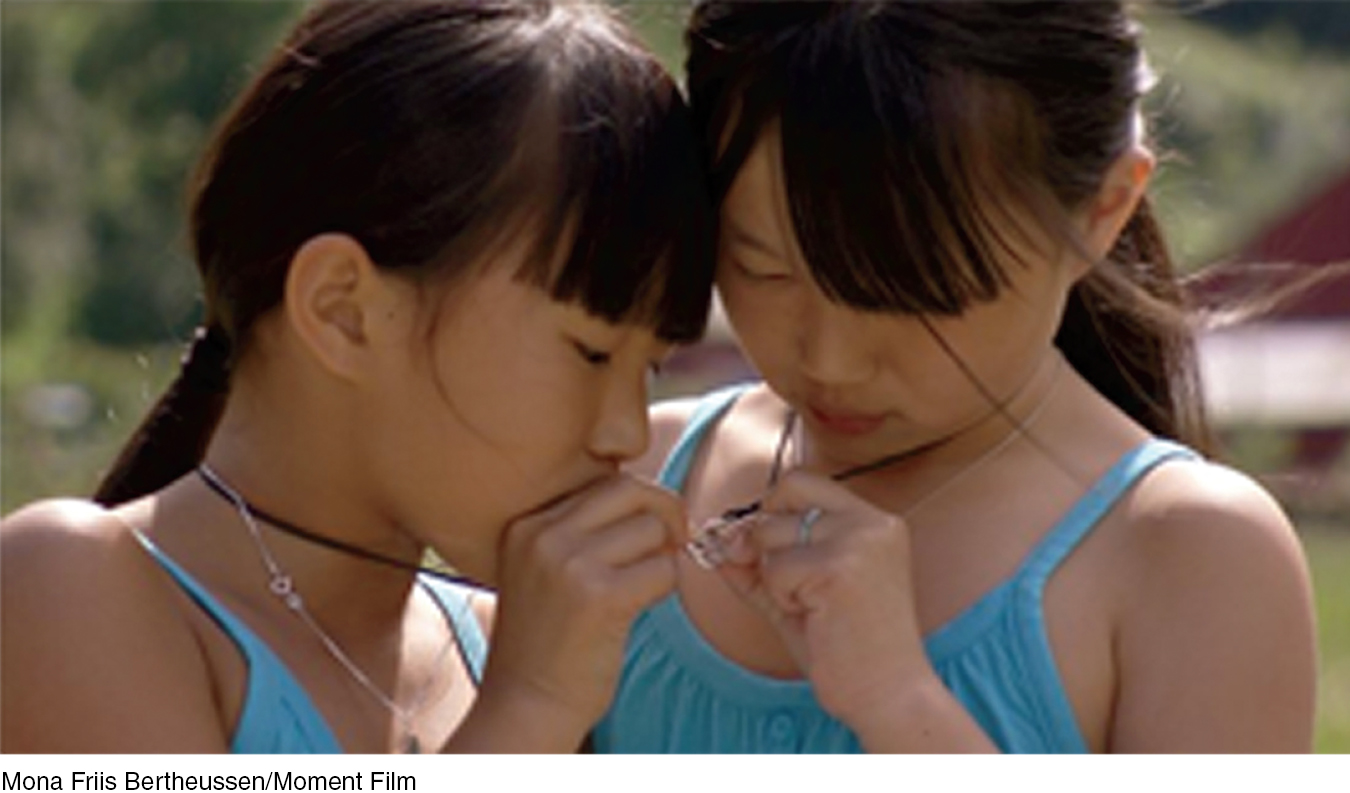
If genetic influences help explain individual differences, can the same be said of trait differences between groups? Not necessarily. Individual differences in height and weight, for example, are highly heritable; yet nutrition (an environmental factor) rather than genetic influences explains why, as a group, today’s adults are taller and heavier than those of a century ago. The two groups differ, but not because human genes have changed in a mere century’s eyeblink of time. Ditto aggressiveness, a genetically influenced trait. Today’s peaceful Scandinavians differ from their more aggressive Viking ancestors, despite carrying many of the same genes.
BIOLOGICAL VERSUS ADOPTIVE RELATIVES For behavior geneticists, nature’s second real-
The stunning finding from studies of hundreds of adoptive families is that, with the exception of identical twins, people who grow up together do not much resemble one another in personality (McGue & Bouchard, 1998; Plomin, 2011; Rowe, 1990). In personality traits such as extraversion and agreeableness, people who have been adopted are more similar to their biological parents than to their caregiving adoptive parents.

The finding is important enough to bear repeating: The environment shared by a family’s children has virtually no discernible impact on their personalities. Two adopted children raised in the same home are no more likely to share personality traits with each other than with the child down the block. Heredity shapes other primates’ personalities, too. Macaque monkeys raised by foster mothers exhibited social behaviors that resembled their biological, rather than foster, mothers (Maestripieri, 2003). Add in the similarity of identical twins, whether they grow up together or apart, and the effect of a shared environment seems shockingly modest.

The genetic leash may limit the family environment’s influence on personality, but it does not mean that adoptive parenting is a fruitless venture. As a new adoptive parent, I [ND] especially find it heartening to know that parents do influence their children’s attitudes, values, manners, politics, and faith (Reifman & Cleveland, 2007). Religious involvement is genetically influenced (Steger et al., 2011). But a pair of adopted children or identical twins will, especially during adolescence, have more similar religious beliefs if raised together (Koenig et al., 2005). Parenting matters!
Moreover, child neglect and abuse and even parental divorce are rare in adoptive homes. (Adoptive parents are carefully screened; biological parents are not.) So it is not surprising that studies have shown that, despite a slightly greater risk of psychological disorder, most adopted children thrive, especially when adopted as infants (Loehlin et al., 2007; van IJzendoorn & Juffer, 2006; Wierzbicki, 1993). Seven in eight adopted children have reported feeling strongly attached to one or both adoptive parents. As children of self-
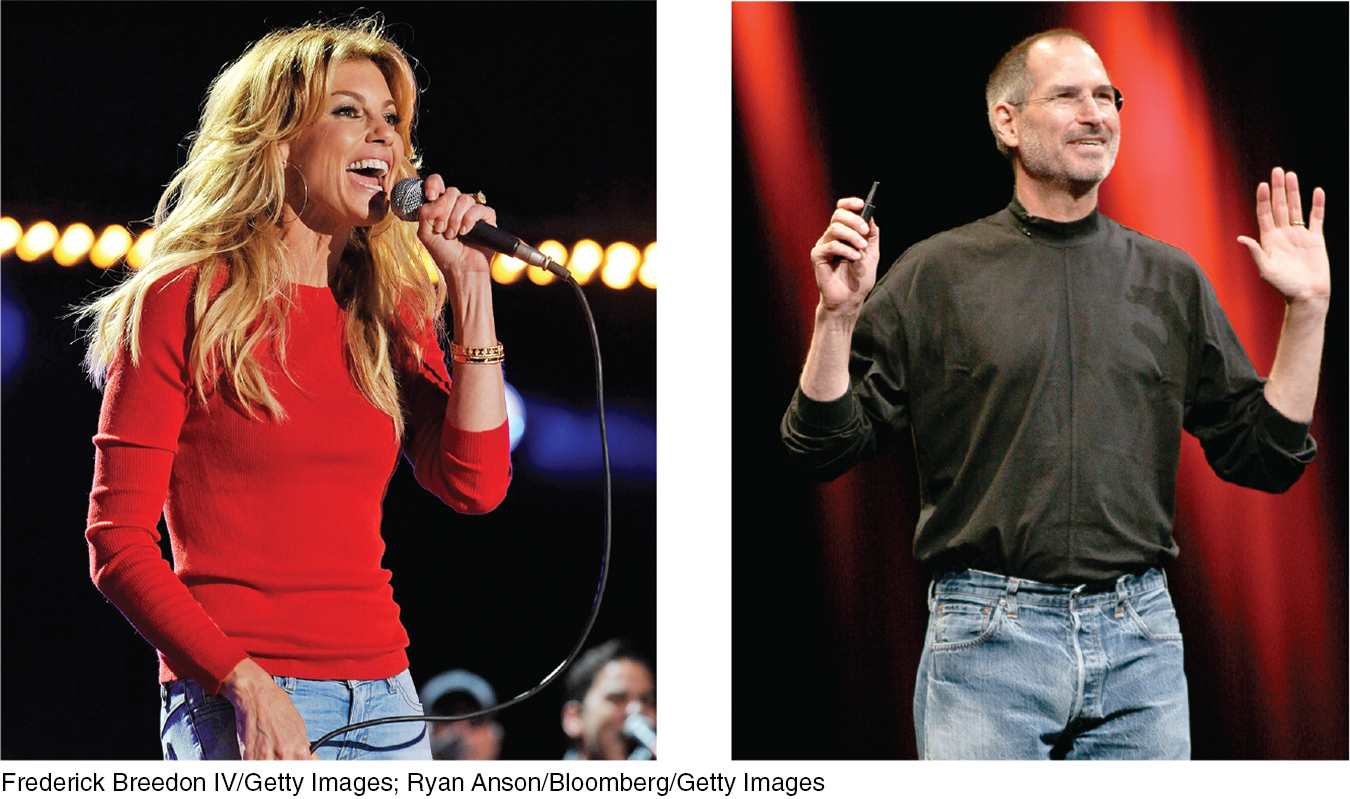
RETRIEVE IT
Question
How do researchers use twin and adoption studies to learn about psychological principles?
Gene-Environment Interaction
2-
Among our similarities, the most important—
“Men’s natures are alike; it is their habits that carry them far apart.”
Confucius, Analects, 500 B.C.E.
Genes and environment—
interaction the interplay that occurs when the effect of one factor (such as environment) depends on another factor (such as heredity).
To say that genes and experience are both important is true. But more precisely, they interact. Imagine two babies, one genetically predisposed to be attractive, sociable, and easygoing, the other less so. Assume further that the first baby attracts more affectionate and stimulating care and so develops into a warmer and more outgoing person. As the two children grow older, the more naturally outgoing child may seek more activities and friends that encourage further social confidence.

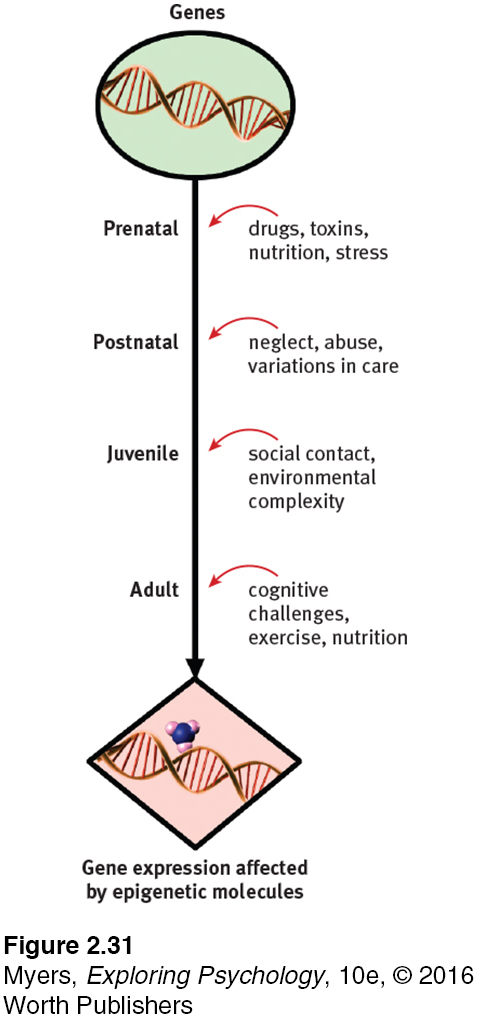
What has caused their resulting personality differences? Neither heredity nor experience act alone. Environments trigger gene activity. And our genetically influenced traits evoke significant responses in others. Thus, a child’s impulsivity and aggression may evoke an angry response from a parent or teacher, who reacts warmly to well-
Identical twins not only share the same genetic predispositions, they also seek and create similar experiences that express their shared genes (Kandler et al., 2012). Evocative interactions may help explain why identical twins raised in different families have recalled their parents’ warmth as remarkably similar—
epigenetics the study of environmental influences on gene expression that occur without a DNA change.
Recall that genes can be either active (expressed, as the hot water activates the tea bag) or inactive. Epigenetics (meaning “in addition to” or “above and beyond” genetics), studies the molecular mechanisms by which environments can trigger or block genetic expression. Our experiences create epigenetic marks, which are often organic methyl molecules attached to part of a DNA strand (FIGURE 2.31). If a mark instructs the cell to ignore any gene present in that DNA segment, those genes will be “turned off”—they will prevent the DNA from producing the proteins coded by that gene. As one geneticist said, “Things written in pen you can’t change. That’s DNA. Things written in pencil you can. That’s epigenetics” (Read, 2012).
Environmental factors such as diet, drugs, and stress can affect the epigenetic molecules that regulate gene expression. Mother rats normally lick their infants. Deprived of this licking in experiments, infant rats had more epigenetic molecules blocking access to their brain’s “on” switch for developing stress hormone receptors. When stressed, those animals had above-
Epigenetics can also help explain why identical twins may look slightly different. Researchers studying mice have found that in utero exposure to certain chemicals can cause genetically identical twins to have different-
 For a 7-
For a 7-
So, if Beyoncé and Jay Z’s daughter, Blue Ivy, grows up to be a popular recording artist, should we attribute her musical talent to her “superstar genes”? To her growing up in a musically rich environment? To high expectations? The best answer seems to be “All of the above.” From conception onward, we are the product of a cascade of interactions between our genetic predispositions and our surrounding environments (McGue, 2010). Our genes affect how people react to and influence us. Forget nature versus nurture; think nature via nurture.
RETRIEVE IT
Match the following terms to the correct explanation.
Question
Epigenetics Behavior genetics | Study of the relative effects of our genes and our environment on our behavior. Study of environmental factors that affect how our genes are expressed. |
Evolutionary Psychology: Understanding Human Nature
2-
evolutionary psychology the study of the evolution of behavior and the mind, using principles of natural selection.
natural selection the principle that those chance inherited traits that better enable an organism to survive and reproduce in a particular environment will most likely be passed on to succeeding generations.
Behavior geneticists explore the genetic and environmental roots of human differences. Evolutionary psychologists instead focus mostly on what makes us so much alike as humans. They use Charles Darwin’s principle of natural selection to understand the roots of behavior and mental processes. The idea, simplified, is this:
Organisms’ varied offspring compete for survival.
Certain biological and behavioral variations increase organisms’ reproductive and survival chances in their particular environment.
Offspring that survive are more likely to pass their genes to ensuing generations.
Thus, over time, population characteristics may change.
To see these principles at work, let’s consider a straightforward example in foxes.
Natural Selection and Adaptation
A fox is a wild and wary animal. If you capture a fox and try to befriend it, be careful. Stick your hand in the cage and, if the timid fox cannot flee, it may snack on your fingers. Russian scientist Dmitry Belyaev wondered how our human ancestors had domesticated dogs from their equally wild wolf forebears. Might he, within a comparatively short stretch of time, accomplish a similar feat by transforming the fearful fox into a friendly fox?
To find out, Belyaev set to work with 30 male and 100 female foxes. From their offspring he selected and mated the tamest 5 percent of males and 20 percent of females. (He measured tameness by the foxes’ responses to attempts to feed, handle, and stroke them.) Over more than 30 generations of foxes, Belyaev and his successor, Lyudmila Trut, repeated that simple procedure. Forty years and 45,000 foxes later, they had a new breed of foxes that, in Trut’s (1999) words, were “docile, eager to please, and unmistakably domesticated. . . . Before our eyes, ‘the Beast’ has turned into ‘beauty,’ as the aggressive behavior of our herd’s wild [ancestors] entirely disappeared.” So friendly and eager for human contact were these animals, so inclined to whimper to attract attention and to lick people like affectionate dogs, that the cash-

Over time, traits that give an individual or species a reproductive advantage are selected and will prevail. Animal-
mutation a random error in gene replication that leads to a change.
Does the same process work with naturally occurring selection? Does natural selection explain our human tendencies? Nature has indeed selected advantageous variations from the new gene combinations produced at each human conception plus the mutations (random errors in gene replication) that sometimes result. But the tight genetic leash that predisposes a dog’s retrieving, a cat’s pouncing, or a bird’s nesting is looser on humans. The genes selected during our ancestral history provide more than a long leash; they give us a great capacity to learn and therefore to adapt to life in varied environments, from the tundra to the jungle. Genes and experience together wire the brain. Our adaptive flexibility in responding to different environments contributes to our fitness—
RETRIEVE IT
Question
How are Belyaev and Trut's breeding practices similar to, and how do they differ from, the way natural selection normally occurs?
Evolutionary Success Helps Explain Similarities
Our behavioral and biological similarities arise from our shared human genome, our common genetic profile. How did we develop our genetic kinship?
OUR GENETIC LEGACY At the dawn of human history, our ancestors faced certain questions: Who is my ally, who is my foe? With whom should I mate? What food should I eat? Some individuals answered those questions more successfully than others. For example, women who experienced nausea in the critical first three months of pregnancy were genetically predisposed to avoid certain bitter, strongly flavored, and novel foods. Avoiding such foods has survival value, since they are the very foods most often toxic to prenatal development (Profet, 1992; Schmitt & Pilcher, 2004). Early humans disposed to eat nourishing rather than poisonous foods survived to contribute their genes to later generations. Those who deemed leopards “nice to pet” often did not.

Similarly successful were those whose mating helped them produce and nurture offspring. Over generations, the genes of individuals not so disposed tended to be lost from the human gene pool. As success-
Despite high infant mortality and rampant disease in past millennia, not one of your countless ancestors died childless.
As inheritors of this prehistoric legacy, we are genetically predisposed to behave in ways that promoted our ancestors’ surviving and reproducing. But in some ways, we are biologically prepared for a world that no longer exists. We face problems our ancestors could not imagine, such as how to create the perfect online dating profile or how to overcome the urge to constantly check our smart phones (Parkinson & Wheatley, 2015). We love the taste of sweets and fats, nutrients that prepared our physically active ancestors to survive food shortages. But few of us now hunt and gather our food. Too often, we search for sweets and fats in fast-
Those who are troubled by an apparent conflict between scientific and religious accounts of human origins may find it helpful to consider that different perspectives of life can be complementary. For example, the scientific account attempts to tell us when and how; religious creation stories usually aim to tell about an ultimate who and why. As Galileo explained to the Grand Duchess Christina, “The Bible teaches how to go to heaven, not how the heavens go.”
EVOLUTIONARY PSYCHOLOGY TODAY Darwin’s theory of evolution has become one of biology’s organizing principles. “Virtually no contemporary scientists believe that Darwin was basically wrong,” noted Jared Diamond (2001). Today, Darwin’s theory lives on in the second Darwinian revolution, the application of evolutionary principles to psychology. In concluding On the Origin of Species, Darwin (1859, p. 346) anticipated this, foreseeing “open fields for far more important researches. Psychology will be based on a new foundation.”
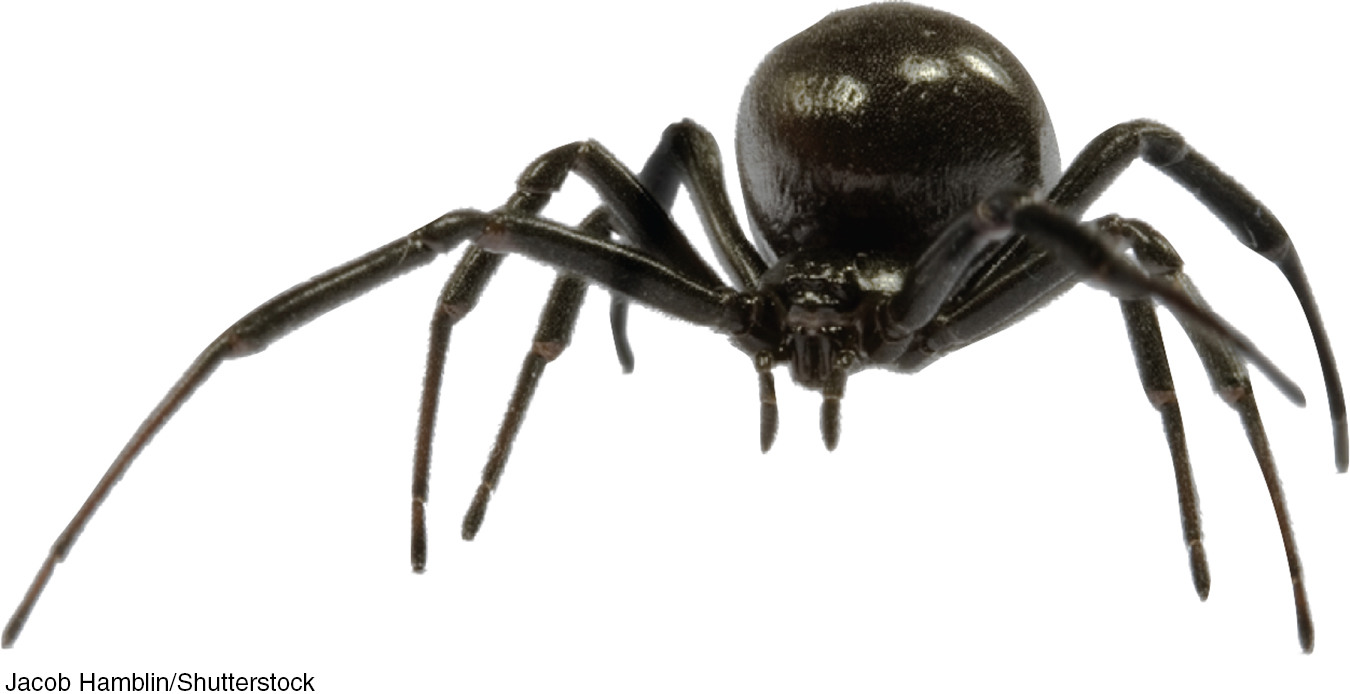
Elsewhere in this text, we address questions that intrigue evolutionary psychologists: Why do infants start to fear strangers about the time they become mobile? Why are biological fathers so much less likely than unrelated boyfriends to abuse and murder the children with whom they share a home? Why do so many more people have phobias about spiders, snakes, and heights than about more dangerous threats, such as guns and electricity? And why do we fear air travel so much more than driving?
* * *
We know from our correspondence and from surveys that some readers are troubled by the naturalism and evolutionism of contemporary science. (A note to readers from other nations: In the United States there is a wide gulf between scientific and lay thinking about evolution.) “The idea that human minds are the product of evolution is . . . unassailable fact,” declared a 2007 editorial in Nature, a leading science journal. In The Language of God, Human Genome Project director Francis Collins (2006, pp. 141, 146), a self-
When Isaac Newton explained the rainbow in terms of light of differing wavelengths, the British poet John Keats feared that Newton had destroyed the rainbow’s mysterious beauty. Yet, as evolutionary biologist Richard Dawkins (1998) noted in Unweaving the Rainbow, Newton’s analysis led to an even deeper mystery—
When Galileo assembled evidence that Earth revolved around the Sun, not vice versa, he did not offer irrefutable proof for his theory. Rather, he offered a coherent explanation for a variety of observations, such as the changing shadows cast by the Moon’s mountains. His explanation eventually won the day because it described and explained things in a way that made sense, that hung together. Darwin’s theory of evolution likewise is a coherent view of natural history. It offers an organizing principle that unifies various observations.
Many people of faith find the scientific idea of human origins congenial with their spirituality. In the fifth century, St. Augustine (quoted by Wilford, 1999) wrote, “The universe was brought into being in a less than fully formed state, but was gifted with the capacity to transform itself from unformed matter into a truly marvelous array of structures and life forms.” Some 1600 years later, Pope Francis in 2014 welcomed a science-
Meanwhile, many people of science are awestruck at the emerging understanding of the universe and the human creature. It boggles the mind—
What caused this almost-
Rather than fearing science, we can welcome its enlarging our understanding and awakening our sense of awe. In The Fragile Species, Lewis Thomas (1992) described his utter amazement that Earth in time gave rise to bacteria and eventually to Bach’s Mass in B Minor. In a short 4 billion years, life on Earth has come from nothing to structures as complex as a 6-
REVIEW Genetics, Evolutionary Psychology, and Behavior
Learning Objectives
Test Yourself by taking a moment to answer each of these Learning Objective Questions (repeated here from within the chapter). Research suggests that trying to answer these questions on your own will improve your long-
Question
2-
Question
2-
Question
2-
Question
2-
Terms and Concepts to Remember
Test yourself on these terms.
Question
environment (p. 66) heredity (p. 66) behavior genetics (p. 66) chromosomes (p. 66) DNA (deoxyribonucleic acid) (p. 66) genes (p. 66) genome (p. 66) identical (monozygotic) twins (p. 67) fraternal (dizygotic) twins (p. 68) interaction (p. 71) epigenetics (p. 72) evolutionary psychology (p. 73) natural selection (p. 73) mutation (p. 74) | the interplay that occurs when the effect of one factor (such as environment) depends on another factor (such as heredity). the biochemical units of heredity that make up the chromosomes; segments of DNA capable of synthesizing proteins. every nongenetic influence, from prenatal nutrition to the people and things around us. the study of environmental influences on gene expression that occur without a DNA change. the complete instructions for making an organism, consisting of all the genetic material in that organism's chromosomes. a complex molecule containing the genetic information that makes up the chromosomes. threadlike structures made of DNA molecules that contain the genes. the principle that those chance inherited traits that better enable an organism to survive and reproduce in a particular environment will most likely be passed on to succeeding generations. develop from a single fertilized egg that splits in two, creating two genetically identical organisms. develop from separate fertilized eggs. They are genetically no closer than ordinary brothers and sisters, but they share a prenatal environment. a random error in gene replication that leads to a change. the genetic transfer of characteristics from parents to offspring. the study of the relative power and limits of genetic and environmental influences on behavior. the study of the evolution of behavior and the mind, using principles of natural selection. |
Experience the Testing Effect
Test yourself repeatedly throughout your studies. This will not only help you figure out what you know and don’t know; the testing itself will help you learn and remember the information more effectively thanks to the testing effect.
Question 2.29
1. The threadlike structures made largely of DNA molecules are called .
Question 2.30
2. A small segment of DNA that codes for particular proteins is referred to as a .
Question 2.31
3. When the mother's egg and the father's sperm unite, each contributes
| A. |
| B. |
| C. |
| D. |
Question 2.32
4. Fraternal twins result when
| A. |
| B. |
| C. |
| D. |
Question 2.33
5. twins share the same DNA.
Question 2.34
6. Adoption studies seek to understand genetic influences on personality. They do this mainly by
| A. |
| B. |
| C. |
| D. |
Question 2.35
7. Epigenetics is the study of the molecular mechanisms by which trigger or block genetic expression.
Question 2.36
8. Behavior geneticists are most interested in exploring (commonalities/differences) in our behaviors. Evolutionary psychologists are most interested in exploring (commonalities/differences).
Question 2.37
9. Evolutionary psychologists are most likely to focus on
| A. |
| B. |
| C. |
| D. |
Use  to create your personalized study plan, which will direct you to the resources that will help you most in
to create your personalized study plan, which will direct you to the resources that will help you most in  .
.